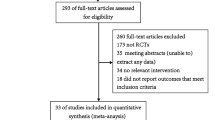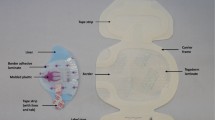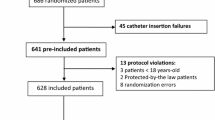Abstract
Central venous catheters (CVCs) are widely used in critically ill patients in intensive care units. However, infectious complications are common and may limit their utility. We critically review the literature to determine the impact of CVC design amd composition, insertion site selection, insertion procedures, care and removal of temporary CVCs on infectious complications. Relevant articles were identified and selected for review using a database search (Medline and manual of the English language literature) based upon study design and sample size with an emphasis on prospective randomized trials. To minimize infectious complications and maintain a reasonable cost-benefit ratio, we recommend: i) use a single lumen catheter unless clear indications for a multi-lumen catheter exist; ii) insert the catheter via the subclavian vein if no relative contraindication exists (bleeding diathesis, positive pressure ventilation); iii) disinfect the insertion site employing sterile technique; iv) apply a dry, sterile dressing and change the dressing every other day; v) inspect the insertion site for signs of infection and remove the catheter if pus is present; vi) if a catheter-related infection is suspected, change the catheter over a guidewire and culture the distal segment. The replacement catheter should be removed if an original catheter segment culture is positive.
Similar content being viewed by others
References
Hampton AA, Sheretz RJ (1988) Vascular access infections in hospitalized patients. Surg Clin North Am 68: 57–71
Maki DG, Band JD (1981) A comparative study of polyantibiotic and iodophor ointments in prevention of vascular catheter-related infection. Am J Med 70:739–744
Bone RC, Balk RA, Cerra FB, Dellinger RP et al (1992) American College of Chest Physicians/Society of Critical Care Medicine consensus conference: definitions for sepsis and organ failure and guidelines for the use of innovative therapies in sepsis. Crit Care Med 20: 864–874
Maki DG, Weise CE, Sarafin HW (1977) A semiquantitative culture method for indentifying intravenous-catheter-related infection. N Engl J Med 296: 1305–1309
Cleri DJ, Corrado ML, Seligman SJ (1980) Quantitative culture of intravenous catheters and other intravascular inserts. J Infect Dis 141:781–786
Kelly CS, Ligas JR, Smith CA, Madden GM et al (1986) Sepsis due to triple lumen central venous catheters. Surg Gynecol Obstet 163:14–16
Stillman R, Soliman F, Garcia L, Sawyer P (1977) Etiology of catheter-associated sepsis: correlation with thrombogenicity. Arch Surg 112:1497–1499
Hoshal VL Jr, Ause RG, Hoskins PA (1971) Fibrin sleeve formation on indwelling subclavian central venous catheters. Arch Surg 102:353–358
Fabri PJ, Mortallo JM, Ebbert ML, Kudsk KA et al (1984) Clinical effect of nonthrombotic total parenteral nutrition catheters. JPEN 8:705–707
Kudsk KA, Powell C, Mirtallo JM, Fabri PJ et al (1985) Heparin does not reduce catheter sepsis during total parenteral nutrition. JPEN 9:348–349
Bailey MJ (1979) Reduction of catheter-associated sepsis in parenteral nutrition using low-dose intravenous heparin. BMJ 23:1671–1673
Kamal GD, Pfaller MA, Rempe LE, Jebson PJ (1991) Reduced intravascular catheter infection by antibiotic bonding: a prospective, randomized, controlled trial. JAMA 265:2364–2368
Maki DG, Wheeler SJ, Stolz SM, Mermel LA (1991) Clinical trial of a novel antiseptic central venous catheter. The 31st Interscience Conference on Antimicrobial Agents and Chemotherapy, Chicago, September 29-October 2:176 (Abstract)
Pemberton LB, Lyman B, Lander V, Covinsky J (1989) Sepsis from triple- vs single-lumen catheters during total parenteral nutrition in surgical or critically ill patients. Arch Surg 121: 591–594
Hilton E, Haslett T, Borenstein MT, Isenberg JD et al (1988) Central catheter infections: single- versus triple-lumen catheters; influence of guide wires on infection rates when used for replacement of catheters. Am J Med 84:667–672
McCarthy MC, Shives JK, Robison RJ, Broadie RA (1987) Prospective evaluation of single and triple lumen catheters in total parenteral nutrition. JPEN 11:259–262
Miller JJ, Venus B, Mathru M (1984) Comparison of the sterility of long-term central venous catheterization using single lumen, triple lumen, and pulmonary artery catheters. Crit Care Med 12:634–637
Bernard RW, Stahl WM, Chase RM (1971) Subclavian vein catheterizations: a prospective study; II. Infectious complications. Ann Surg 173:191–200
Farkas JC, Liu N, Bleriot JP, Chevret S et al (1992) Single- versus triple-lumen central catheter-related sepsis: a prospective randomized study in a critically ill population. Am J Med 93: 277–282
Pomp A, Stella L, Caldwell D, Albina J (1988) Catheter-related sepsis: single lumen catheters (SLC) vs triple lumen catheters (TLC) JPEN 12:23s (Abstract)
Lee RB, Buckner R, Sharp KW (1988) Do multi-lumen catheters increase central venous catheter sepsis compared to single-lumen catheters? J Trauma 28: 1472–1475
Applefeld JJ, Caruthers TE, Reno DS Civetta JM (1978) Assessment of the sterility of long term cardiac catheterization using the thermodilution Swan-Ganz catheter. Chest 74:377–380
Kaye W, Wheaton M, Potter-Bynoe G (1983) Radial and pulmonary artery catheter-related sepsis. Crit Care Med 11:249–252
Hudson-Civetta JA, Civetta JM, Martinez OV, Hoffman TA (1987) Risk and detection of pulmonary artery catheter-related infection in septic surgical patients. Crit Care Med 15:29–34
Johnston WE, Prough DS, Royster RL, Peacock JE et al (1984) Short-term sterility of the pulmonary artery catheter inserted through an external plastic shield. Anesth 61:461–464
Bach A, Bohrer H, Geiss HK (1992) Safety of a guidewire technique for replacement of pulmonary artery catheters. J Cardiothorac Vasc Anesth 6: 711–714
Kaiser CW, Koornick AR, Smith N, Soroff HS (1981) Choice of route for central venous cannulation: subclavian or internal jugular vein? A prospective randomized study. J Surg Oncol 17: 345–354
Senagore A, Waller JD, Bonnell BW, Bursch LR et al (1987) Pulmonary artery catheterization: a prospective study of internal jugular and subclavian approaches. Crit Care Med 15:35–37
Burr C, Ainefeld EW (1978) The caval catheter. Springer, Berlin, pp 39–65
Sessler CN, Glauser FL (1987) Central venous cannulation done by house officers in the intensive care unit: a prospective study. South Med J 80: 1239–1248
Gil RR, Kruse JA, Thill-Baharozian MC, Carlson RW (1989) Triple- vs single-lumen central venous catheters. Arch Intern Med 149:1139–1143
Collignon P, Soni N, Pearson I, Sorrell T et al (1988) Sepsis associated with central vein catheters in critically ill patients. Intensive Care Med 14:227–231
Brun-Buisson C, Abrouk F, Legrand P, Huet Y et al (1987) Diagnosis of central venous catheter-related sepsis; critical level of quantitative tip cultures. Arch Intern Med 147:873–877
Pinilla JC, Ross DF, Martin T, Crump H (1983) Study of the incidence of intravascular catheter infection and associated septicemia in critically ill patients. Crit Care Med 11:21–25
Bjornson HS, Colley R, Bower RH, Duty VP et al (1982) Association between microorganism growth at the catheter insertion site and colonization of the catheter in patients receiving total parenteral nutrition. Surgery 92:720–727
Snydman DR, Pober BR, Murray SA, Gorbea HF et al (1982) Predictive value of surveillance skin cultures in total-parenteral-nutrition-related infection. Lancet II:1385–1388
Maki DG, Ringer M, Alvarado CJ (1991) Prospective randomized trial of povidone-iodine, alcohol, and chlorhexidine for prevention of infection associated with central venous and arterial catheters. Lancet 338:339–343
Bozzetti F, Terno G, Bonfanti G, Scarpa D et al (1983) Prevention and treatment of central venous catheter sepsis by exchange via a guidewire. Ann Surg 198:48–52
Sitzmann JV, Townsend TR, Siler MC, Bartlett JG (1984) Septic and technical complications of central venous catheterization: a prospective study of 200 consecutive patients. Ann Surg 202: 766–770
Powell CR, Traetow MJ, Fabri PJ, Kudsk KA et al (1985) Op-site dressing study: a prospective randomized study evaluating povidone iodine ointment and extension set changes with 7-day op-site dressings applied to total parenteral nutrition subclavian sites. JPEN 9:443–446
Maki DG, McCormack KN (1987) Defatting catheter insertion sites in total parenteral nutrition is of no value as an infection control measure. Am J Med 83:833–840
Essop AR, Frolich J, Moosa MR, Miller M et al (1984) Risk factors related to bacterial contamination of indwelling vascular catheters in non-infected hosts. Intensive Care Med 10: 193–195
Prager RL, Silva J Jr (1984) Colonization of central venous catheters. South Med J 77:458–461
Armstrong CW, Mayhall CG, Miller KB, Newsome HH Jr et al (1986) Prospective study of catheter replacement and other risk factors for infection of hyperalimentation catheters. J Infect Dis 154:808–816
Conly JM, Grieves K, Peters B (1989) A prospective, randomized study comparing transparent and dry gauze dressings for central venous catheters. J Infect Dis 159:310–319
Maki DG, Cobb L, Garman JK, Shapiro JM et al (1988) An attachable silver-impregnated cuff for prevention of infection with central venous catheters: a prospective randomized multicenter trial. Am J Med 85:307–314
Flowers RHIII, Schwenzer KJ, Kopel RF, Fisch MJ et al (1989) Efficacy of an attachable subcutaneous cuff for the prevention of intravascular catheter-related infection. JAMA 261:878–883
Welch GW, McKeel DW, Silverstein P, Walker HL (1974) The role of catheter composition in the development of thrombophlebitis. Ann Intern Med 138: 421–424
Powell C, Regan C, Farri PJ, Ruberg RL (1982) Evaluation of opsite catheter dressings for parenteral nutrition: a prospective, randomized study. JPEN 6:43–46
Ricard P, Martin R, Marcoux JA (1985) Protection of indwelling vascular catheters: incidence of bacterial contamination and catheter-related sepsis. Crit Care Med 13:541–543
McCredie KB, Lawson M, Marts K, Stern J (1984) A comparative evaluation of transparent dressings and gauze dressings for central venous catheters. JPEN 8:96
Hoffmann KK, Weber DJ, Samsa GP, Rutala WA (1992) Transparent polyurethane-film as an intravenous catheter dressing: a meta-analysis of the infection rates. JAMA 267:2072–2076
Hill RL, Fisher AP, Ware RJ, Wilson S et al (1990) Mupirocin for the reduction of colonization of internal jugular cannulae-a randomized controlled trial. J Hosp Infect 15:311–321
Samsoondar W, Freeman JB (1985) Colonization of intravascular monitoring devices. Crit Care Med 13:753–755
Moyer MA, Edwards LD, Farley L (1983) Comparative culture methods on 100 intravenous catheters: routine, semiquantitative, and blood cultures. Arch Intern Med 143:66–69
Weinstein RA, Emori TG, Anderson RL, Stamm WE (1976) Pressure transducers as a source of bacteremia after open heart surgery: report of an outbreak and guidelines for prevention. Chest 69:338–344
Weinstein RA, Stamm WE, Kramer L, Corey L (1976) Pressure monitoring devices: overlooked source of nosocomial infection. JAMA 236:936–938
Buxton AE, Anerson RL, Klimek J, Quintiliani R (1978) Failure of disposable domes to prevent septicemia acquired from contaminated pressure transducers. Chest 74:508–513
Dryden GE; Brickler J (1979) Stopcock contamination. Anesth Analg 58: 141–142
Sitges-Serra A, Puig P, Linares J, Perez JL et al (1984) Hub colonization as the initial step in an outbreak of catheter-related sepsis due to coagulase negative staphylococci during parenteral nutrition. JPEN 8:668–672
Falchuk KH, Peterson L, McNeil BJ (1985) Microparticulate-induced phlebitis: its prevention by in-line filtration. N Engl J Med 312:78–82
Sitges-Serra A, Linares J, Perez JL, Jaurrieta E et al (1985) A randomized trial of the effect of tubing changes on hub contamination and catheter sepsis during parenteral nutrition. JPEN 9:322–325
Band JD, Maki DG (1979) Safety of changing intravenous delivery systems at longer than 24-hour intervals. Ann Intern Med 91:173–178
Gorbea HF, Snydman DR, Delaney A, Stockman J et al (1984) Intravenous tubing with burettes can be safely changed at 48-hour intervals. JAMA 215:2112–2115
Snydman DR, Donnelly-Reidy M, Perry LK, Martin WJ (1987) Intravenous tubing containing burettes can be safely changed at 72 hour intervals. Infect Control 8:113–116
Maki DG, Botticelli JT, LeRoy ML, Thielke TS (1987) Prospective study of replacing administration sets for intravenous therapy at 48- vs 72-hour intervals. JAMA 258:1777–1781
Gertner J, Herman B, Pescio M, Wolff MA (1979) Risk of infection in prolonged central venous catheterization. Surg Gynecol Obstet 149:567–570
Snyder RH, Archer FJ, Endy T, Allen TW et al (1988) Catheter infection: a comparison of two catheter maintenance techniques. Ann Surg 208: 651–653
Cobb DK, High KP, Sawyer RG, Sable CA et al (1992) A controlled trial of scheduled replacement of central venous and pulmonary-artery catheters. N Engl J Med 327:1062–1068
Eyer S, Brummitt C, Carossley K, Siegel R et al (1990) Catheter-related sepsis: prospective, randomized study of three methods of long-term catheter maintenance. Crit Care Med 18: 1073–1079
Newsome HH, Armstrong CW, Mayhall GC, Sugerman HJ et al (1984) Mechanical complications from insertion of subclavian venous feeding catheters: comparison of de novo percutaneous venipuncture to change of catheter over guidewire. JPEN 8: 560–562
Hagley MT, Martin B, Gast P, Traeger SM (1992) Infections and mechanical complications of central venous catheters placed by percutaneous venipuncture and over guidewires. Crit Care Med 20:1426–1430
Pettigrew RA, Lang SDR, Haydock DA, Parry BR et al (1985) Catheter-related sepsis in patients on intravenous nutrition: a prospective study of quantitative catheter cultures and guidewire changes for suspected sepsis. Br J Surg 72:52–55
Cercenado E, Ena J, Rodriguez-Crexems M, Romero I et al (1990) A conservative procedure for the diagnosis of catheter-related infections. Arch Intern Med 150:1417–1420
Author information
Authors and Affiliations
Rights and permissions
About this article
Cite this article
Reed, C.R., Sessler, C.N., Glauser, F.L. et al. Central venous catheter infections: Concepts and controversies. Intensive Care Med 21, 177–183 (1995). https://doi.org/10.1007/BF01726542
Received:
Accepted:
Issue Date:
DOI: https://doi.org/10.1007/BF01726542




